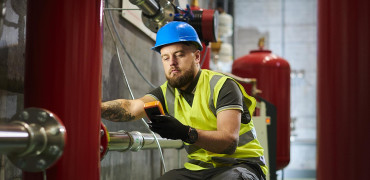Anyone who visited the recent InstallerShow, held at the NEC in the last week of June, and also attended the same exhibition when it was first staged at the Coventry Ricoh Arena back in 2015, would have been struck not only by the growth in size of the event and the number of companies involved, but also by a notable change to the types of products on display.
Just nine years ago, the main focus on many of the stands was the latest boilers and components designed for traditional gas heating systems, but while such products might still be on display in 2024, it was heat pumps and other low carbon solutions that took pride of place for the majority of manufacturers and distributors.
The exhibition, which has succeeded in attracting an increasing number of visitors over the years, thereby provides a good indication of how the UK’s heating industry has changed in recent times and is likely to continue to evolve in the years ahead.
The show has widened its appeal from its core audience of plumbing and heating engineers
Impressive line up
The organisers of this year’s show have been able to boast record levels of both exhibitors and visitors, proving that many professionals and tradespeople are willing to give up time and take the opportunity to learn about new products and network with industry colleagues.
Over 20,000 attended over the three days. Some may well have been enticed by the prospect of being able to take advantage of the plentiful giveaways and prize-winning competitions on offer, but for the more serious minded there was also an impressive programme of presentations and discussions on topical industry issues.
Unsurprisingly, how best to address the challenge of decarbonisation was one of the key themes of the show and some of the industry’s leading experts debated what needs to be done for the country to meet its net zero targets.
With a focus on solar PV and solar thermal systems, there was also a solar innovations zone which staged some practical demonstrations as well as sessions dedicated to battery storage and the relationship between heat pump and solar technologies.
A heat pump for all seasons
With so many heat pumps on display, it can’t be an easy task for some of those new to the technology, and even for more experienced heat pump installers, to properly evaluate the relative features and benefits of the various models and different refrigerants promoted by the exhibitors.
Recognising the need for training and technical support, most manufacturers have invested in those back-up services for installers, but will that support still be available in five years’ time? Not all suppliers have the experience and resources of Mitsubishi Electric to provide that peace of mind.
The UK heat pump market is set for significant growth, but surely there isn’t going to be room for all the suppliers who are currently trying to get a slice of the market and there are bound to be some winners and losers over the coming years.
Taking control
Controls and other essential components also have a big part to play in the ultimate performance of any heating system and any aspiring installers would have been well advised to take some time at the show to seek out the latest advances in increasingly sophisticated and inter-connected controls technology.
Reading about a product or looking it up online is one thing, but having the opportunity to talk through how something works with a knowledgeable product manager or salesperson provides an insight that can’t be matched by a brochure.
Future-proof
As the show continues to extend its scope and embrace other aspects of the building services industry, it has naturally widened its appeal from its core audience of plumbing and heating engineers and now welcomes an increasing number of electricians, renewable energy specialists and multi-trades.
It has been said that the boundaries between separate trades have started to blur in recent years, reflecting the fact that the shift away from traditional fossil fuels and the development of more energy-efficient homes requires a multi-disciplined approach, and the InstallerShow again offers an insight into how the industry might continue to evolve.
The event has helped to highlight the need for a more collaborative approach to projects and provides a useful platform for partnerships between suppliers and different trades to be developed.
So, for those installers looking to future-proof their business, a trip to the NEC next June might mean sacrificing some time away from the work of today, but it could prove to be invaluable when it comes to enhancing the prospect of winning more work in the years ahead.
Chris Jones is editor of PHAM News




